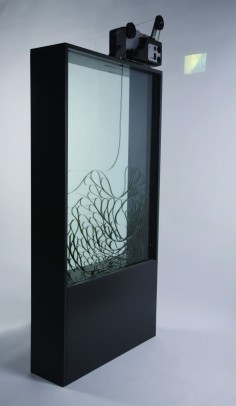ELIZABETH MCALPINE
’98m

source: elizabethmcalpine
Description: A duration of 20 minutes of Super 8 mm film plays on a loop. Footage that pans from the base of the Campanile in Venice to the top is projected in postcard size onto the wall. The film falls and loops within a glass structure, visible to the viewer. McAlpine has used 98 metres of Super 8 mm film to film the 98 metre high structure of the Campanile.
.
.
.
.
.
.
.
source: kadistorg
Le travail d’Elizabeth McAlpine est souvent lié à la question du temps et à l’expérience du regard. Dans « The Height of the Campanile », l’artiste a calculé la durée de son film en fonction de la hauteur de son sujet, le Campanile, de sorte qu’au final la longueur de la pellicule soit équivalente à celle de la tour. De même, le temps nécessaire pour visionner le film et le rythme du travelling effectué par la caméra correspondent. Ainsi, tandis que nombre des oeuvres de McAlpine sont basées sur le montage, la répétition et la fragmentation, « 98m » se présente comme un simple plan-séquence.
L’image, au grain apparent, est projetée au mur à la taille d’une carte postale, pendant que le film forme une boucle au sein d’une structure en verre pensée par l’artiste. La taille de la projection rappelle que Venise est devenue une destination touristique incontournable. L’utilisation du Super 8 est une évocation de la pratique amateur – précédant l’invention de la vidéo, du touriste fixant le souvenir de ses vacances pour le projeter une fois rentré à la maison. Si ce support procure à l’oeuvre un caractère daté, la boucle continue et hypnotique formée par la pellicule suggère au contraire une certaine intemporalité, semblable à celle que peut ressentir le touriste qui découvre San Marco.
.
.
.
.
.
.
.
source: aa2aorg
EIizabeth McAlpine works mainly with time-based media and she describes her working practice as close to geology. She tracks the repetitions and gestures inherent In popular media, extracting pieces of found material from its archive, and repositions them in ways that reveal patterns and associations previously unconsidered.
EIizabeth McAlpine is working on a series of works titled Fiction Map; these pieces use text of landmarks and street names taken from American fiction and organize them to create a real geographical route. The project is ongoing and attempts to create a route from the East to the West coast of the USA. The opportunity to be part of the AA2A scheme at Camberwell College will allow the collection of landmarks to be realized Into a series of maps, which In turn will be made as Iarge-scale etchings and a limited edition book.
Elizabeth McAlpine is based In London and studied MFA sculpture at the Slade School of Fine Art and Fine Art and Critical Theory at Goldsmiths, London.
.
.
.
.
.
.
.
source: timeout
British artist Elizabeth McAlpine is known for her labor-intensive reworkings of appropriated feature footage, but here she weaves her own films and a group of photo-sculptures into a poetic mapping of the urban landscape.
Each sculpture consists of a single sheet of exposed photo paper, folded into a simple three-dimensional shape, mounted onto a supporting steel plate with magnets. The images, contact-printed on both sides, derive from rubbings the artist makes of sidewalks. The results would almost be too elegant, if not for the way her photos droop or curl away from their backings.
The same subject also stars in McAlpine’s two looped short films. In one, an assistant “plays” the cracks in a sidewalk by dragging a large metal needle (topped with an amplifying cone) along them, like grooves in a record. In the second, McAlpine animates rubbings of pavement, whose textures race past to mesmerizing, abstract effect.
McAlpine focuses on her materials’ physical properties—light, paper, magnets, concrete—while taking into account more subjective decisions: where to fold a photograph, where to place a magnet and where to take the next step.

